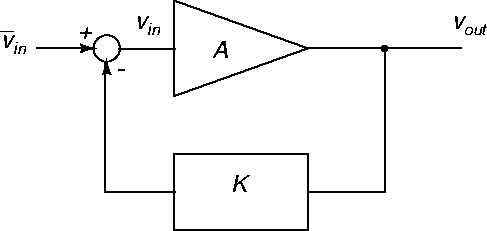 |
Feedback is when the output is applied in some way to the input.
In a PA system, you get feedback when you put the microphone in front of a speaker. This is positive feedback, and the sound gets uncontrollably loud (you have probably heard this unpleasant effect); the output gets added to the input, gets amplified again, and this process continues. This is an example of an unstable system.
Negative feedback is when the output is subtracted from the input. To make this clear, look at the Figure 4.
Figure 4
is a block diagram, and defines the signals (e.g. voltages) and the
components which process them (e.g. electronic circuits). The equations from
this block diagram are
Make sure you understand how to read block diagrams like this. The block diagram Figure 4 and equations (2) are equivalent.
Example. Speed control, as in some modern cars, is an example of the use of negative feedback. If the car starts to speed up above the desired set-point speed, negative feedback causes the throttle to close, thereby reducing speed; similarly, if the car slows, negative feedback acts to open the throttle.
ANU Engineering - ENGN2211